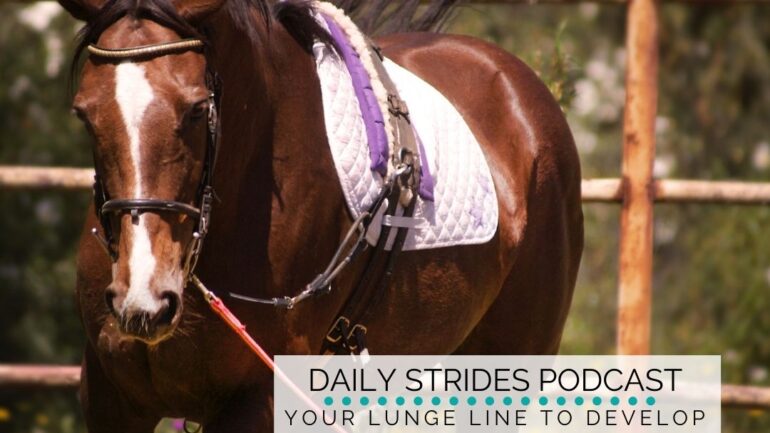Alert… Big statement ahead! Your lunge line is not there to keep your horse on the circle while lunging. I would love for you to take a moment just to consider this statement. Is it at all possible that you have been using your lunge line, in some shape way or form to do this for you? If lunging is not enjoyable, a tug of war, or just too darn difficult, this could be why.
Have you been using your lunge line to keep your horse on the circle, rather than to develop contact and connection with your horse?
Here is my step by step system to turn that around for you in your lunging…
Embrace Artificial Aids
Your lunge line is an artificial aid. And artificial aids are fantastic if used correctly. The keyword is “correctly”. Many riders have allowed themselves to be led down a path where the use of artificial aids, such as lunge lines, lunge whips, or lunging arenas, is frowned upon.
Artificial aids are there to back up or support your natural aids.
And, you can always refine your natural aids, over time, to the point where artificial aids are no longer needed or used all the time. In fact, this is one of your responsibilities as a rider. Doing the work to refine your aids.
Setting up a Boundary
An arena boundary is an artificial aid. Setting one up will take about 30 minutes of your time and the effect will be dramatic in your lunging. Simply mark out a 20m by 20m space using pegs, tape, jumping uprights, jumping poles, or whatever you have to hand. Make sure it is safe, obviously! And that is it visible.
The boundary fence allows you to put pressure on your horse in order to more clearly communicate what you want him to do.
In order to help establish the boundary, I first suggest using a helper. Have the helper lead your horse while on the lunge. The helper will position themselves on the outside of the horse and the circle. Not between you and your horse. Once the helper has led the horse around on the lunge once or twice, they can ‘vanish’ and you are good to go with your lunging.
Applying Pressure with Your Aids
Once your horse knows the boundary is there, you can use it to begin applying pressure. The pressure is like a squeeze. It is also usually done by applying a combination of aids. Rarely is just one aid used when communicating with your horse.
You can use a combination of your position, your body language, your lunge whip, and your voice, coupled with the boundary fence to apply the pressure.
Just like when riding, it is important that you give the horse somewhere to go when you ask a question or apply pressure. Like a funnel or a chute. When riding, you would allow using your seat. When lunging, your body language, position, and voice will allow your horse to move forwards.
The result of the pressure, and then allowing your horse to respond to the pressure is more energy, and this is where you can begin developing contact.
Encouraging Contact Using Your Lunge Line
When the horse is actively moving forward and creating more energy, you can then begin using your lunge line to help gather this energy. The gathering is how the contact is created. And from here, you can really begin developing your horse’s natural abilities to the fullest of his potential.
Contact is like an agreement. It is when the horse agrees to also begin taking responsibility for his actions and his part in the overall performance.
Over time you will reach a point where the boundary is no longer needed. Your horse will understand what is expected of him and that the lunge line is for contact, not for ‘holding him in place’. Just like in riding.
When you ride, your reins are not for holding your horse. They are for developing contact and connection.
Developing Contact on the Lunge Line
I would love to help you work on developing this with your horse. We can do this together inside of Connection, my online membership for equestrians. In there we work together using a system that sees you revising the 5 essentials you need to successfully, and happily, work with your horse. Groundwork is one of those essentials.
Happy Riding
Lorna
Additional Resources for Equestrians:-
-
-
- “3 Days to Successful Lunging” Guided Audio Training
- Improving Your Riding Coordination & Aids While Lunging
- Join Connection today and transform your riding journey
- Lunging for Riding – 4-week step by step program to transform your lunging experience
- Online community for equestrians working on their mindset & fitness
- Online Community for equestrians focusing on re-schooling horses (and ex-racehorses)
- The Daily Strides Podcast on iTunes
- The Daily Strides Podcast on Stitcher Radio
-

